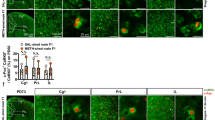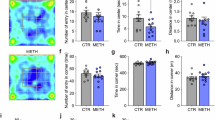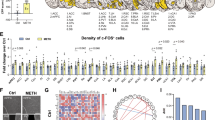Abstract
Aggressive behaviors have been reported in patients who suffer from some psychiatric disorders, and are common in methamphetamine (METH) abusers. Herein, we report that multiple (but not single) injections of METH significantly increased aggressiveness in male CD-1 mice. This increase in aggressiveness was not secondary to METH-induced hyperactivity. Analysis of protein expression using antibody microarrays and Western blotting revealed differential changes in MAP kinase-related pathways after multiple and single METH injections. There were statistically significant (p<0.05) decreases in MEK1, Erk2p, GSK3α, 14-3-3e, and MEK7 in the striata of mice after multiple injections of METH. MEK1 was significantly decreased also after a single injection of METH, but to a much lesser degree than after multiple injections of METH. In the frontal cortex, there was a statistically significant decrease in GSK3α after multiple (but not single) injections of METH. These findings suggest that alterations in MAP kinase-related pathways in the prefronto-striatal circuitries might be involved in the manifestation of aggressive behaviors in mice.
Similar content being viewed by others
Log in or create a free account to read this content
Gain free access to this article, as well as selected content from this journal and more on nature.com
or
References
Bellus SB, Stewart D, Vergo JG, Kost PP, Grace J, Barkstrom SR (1996). The use of lithium in the treatment of aggressive behaviours with two brain-injured individuals in a state psychiatric hospital. Brain Injury 10: 849–860.
Bhat RV, Budd Haeberlein SL, Avila J (2004). Glycogen synthase kinase 3: a drug target for CNS therapies. J Neurochem 89: 1313–1317.
Birger M, Swartz M, Cohen D, Alesh Y, Grishpan C, Kotelr M (2003). Aggression: the testosterone–serotonin link. Israel Med Assoc J 5: 653–658.
Brodkin ES, Goforth SA, Keene AH, Fossella JA, Silver LM (2002). Identification of quantitative trait loci that affect aggressive behavior in mice. J Neurosci 22: 1165–1170.
Brower MC, Price BH (2001). Neuropsychiatry of frontal lobe dysfunction in violent and criminal behaviour: a critical review. J Neurol Neurosurg Psychiatry 71: 720–726.
Cadet JL, Jayanthi S, Deng X (2003). Speed kills: cellular and molecular bases of methamphetamine-induced nerve terminal degeneration and neuronal apoptosis. FASEB J 17: 1775–1788.
Calder AJ, Keane J, Lawrence AD, Manes F (2004). Impaired recognition of anger following damage to the ventral striatum. Brain 127: 1958–1969.
Carey JT, Mandel J (1968). A San Francisco Bay Area ‘speed’ scene. J Health Soc Behav 9: 164–174.
Chen G, Huang LD, Jiang YM, Manji HK (1999). The mood-stabilizing agent valproate inhibits the activity of glycogen synthase kinase-3. J Neurochem 72: 1327–1330.
Chen Z, Gibson TB, Robinson F, Silvestro L, Pearson G, Xu B et al (2001). MAP kinases. Chem Rev 101: 2449–2476.
Chiavegatto S, Dawson VL, Mamounas LA, Koliatsos VE, Dawson TM, Nelson RJ (2001). Brain serotonin dysfunction accounts for aggression in male mice lacking neuronal nitric oxide synthase. Proc Natl Acad Sci USA 98: 1277–1281.
Crowley TJ (1972). Dose-dependent facilitation or suppression of rat fighting by methamphetamine, phenobarbital, or imipramine. Psychopharmacologia 27: 213–222.
Dahlberg LL (1998). Youth violence in the United States. Major trends, risk factors, and prevention approaches. Am J Prev Med 14: 259–272.
Davidge KM, Atkinson L, Douglas L, Lee V, Shapiro S, Kennedy JL et al (2004). Association of the serotonin transporter and 5HT1Dbeta receptor genes with extreme, persistent and pervasive aggressive behaviour in children. Psychiatr Genet 14: 143–146.
Davis S, Vanhoutte P, Pages C, Caboche J, Laroche S (2000). The MAPK/ERK cascade targets both Elk-1 and cAMP response element-binding protein to control long-term potentiation-dependent gene expression in the dentate gyrus in vivo. J Neurosci 20: 4563–4572.
Della Rocca GJ, Mukhin YV, Garnovskaya MN, Daaka Y, Clark GJ, Luttrell LM et al (1999). Serotonin 5-HT1A receptor-mediated Erk activation requires calcium/calmodulin-dependent receptor endocytosis. J Biol Chem 274: 4749–4753.
Dwivedi Y, Rizavi HS, Roberts RC, Conley RC, Tamminga CA, Pandey GN (2001). Reduced activation and expression of ERK1/2 MAP kinase in the post-mortem brain of depressed suicide subjects. J Neurochem 77: 916–928.
Edwards DH, Kravitz EA (1997). Serotonin, social status and aggression. Curr Opin Neurobiol 7: 812–819.
Einat H, Manji HK, Gould TD, Du J, Chen G (2003a). Possible involvement of the ERK signaling cascade in bipolar disorder: behavioral leads from the study of mutant mice. Drug News Perspect 16: 453–463.
Einat H, Yuan P, Gould TD, Li J, Du J, Zhang L et al (2003b). The role of the extracellular signal-regulated kinase signaling pathway in mood modulation. J Neurosci 23: 7311–7316.
Ellinwood Jr EH (1971). Assault and homicide associated with amphetamine abuse. Am J Psychiatry 127: 1170–1175.
Feldker DE, Datson NA, Veenema AH, Meulmeester E, de Kloet ER, Vreugdenhil E (2003). Serial analysis of gene expression predicts structural differences in hippocampus of long attack latency and short attack latency mice. Eur J Neurosci 17: 379–387.
Ferris CF, Stolberg T, Delville Y (1999). Serotonin regulation of aggressive behavior in male golden hamsters (Mesocricetus auratus). Behav Neurosci 113: 804–815.
Freeman WM, Brebner K, Lynch WJ, Robertson DJ, Roberts DC, Vrana KE (2001a). Cocaine-responsive gene expression changes in rat hippocampus. Neuroscience 108: 371–380.
Freeman WM, Nader MA, Nader SH, Robertson DJ, Gioia L, Mitchell SM et al (2001b). Chronic cocaine-mediated changes in non-human primate nucleus accumbens gene expression. J Neurochem 77: 542–549.
Glenn MB, Wroblewski B, Parziale J, Levine L, Whyte J, Rosenthal M (1989). Lithium carbonate for aggressive behavior or affective instability in ten brain-injured patients. Am J Phys Med Rehabil 68: 221–226.
Goetzl U, Grunberg F, Berkowitz B (1977). Lithium carbonate in the management of hyperactive aggressive behavior of the mentally retarded. Compr Psychiatry 18: 599–606.
Gold LH, Geyer MA, Koob GF (1989). Neurochemical mechanisms involved in behavioral effects of amphetamines and related designer drugs. NIDA Res Monogr 94: 101–126.
Golding A (1996). Violence and public health. J R Soc Med 89: 501–505.
Grafman J, Schwab K, Warden D, Pridgen A, Brown HR, Salazar AM (1996). Frontal lobe injuries, violence, and aggression: a report of the Vietnam Head Injury Study. Neurology 46: 1231–1238.
Greengard P (2001). The neurobiology of slow synaptic transmission. Science 294: 1024–1030.
Hao Y, Creson T, Zhang L, Li P, Du F, Yuan P et al (2004). Mood stabilizer valproate promotes ERK pathway-dependent cortical neuronal growth and neurogenesis. J Neurosci 24: 6590–6599.
Hawks D, Mitcheson M, Ogborne A, Edwards G (1969). Abuse of methylamphetamine. Br Med J 1: 715–721.
Huber R, Orzeszyna M, Pokorny N, Kravitz EA (1997). Biogenic amines and aggression: experimental approaches in crustaceans. Brain Behav Evol 50 (Suppl 1): 60–68.
Johansson AK, Hansen S (2000). Increased alcohol intake and behavioral disinhibition in rats with ventral striatal neuron loss. Physiol Behav 70: 453–463.
Jones DH, Martin H, Madrazo J, Robinson KA, Nielsen P, Roseboom PH et al (1995). Expression and structural analysis of 14-3-3 proteins. J Mol Biol 245: 375–384.
Korte SM, Meijer OC, de Kloet ER, Buwalda B, Keijser J, Sluyter F et al (1996). Enhanced 5-HT1A receptor expression in forebrain regions of aggressive house mice. Brain Res 736: 338–343.
Kramer JC, Fischman VS, Littlefield DC (1967). Amphetamine abuse. Pattern and effects of high doses taken intravenously. JAMA 201: 305–309.
Kuikka JT, Tiihonen J, Bergstrom KA, Karhu J, Rasanen P, Eronen M (1998). Abnormal structure of human striatal dopamine re-uptake sites in habitually violent alcoholic offenders: a fractal analysis. Neurosci Lett 253: 195–197.
Lederhendler II (2003). Aggression and violence: perspectives on integrating animal and human research approaches. Horm Behav 44: 156–160.
London ED, Simon SL, Berman SM, Mandelkern MA, Lichtman AM, Bramen J et al (2004). Mood disturbances and regional cerebral metabolic abnormalities in recently abstinent methamphetamine abusers. Arch Gen Psychiatry 61: 73–84.
Maeda H, Sato T, Maki S (1985). Effects of dopamine agonists on hypothalamic defensive attack in cats. Physiol Behav 35: 89–92.
Malone RP, Luebbert J, Pena-Ariet M, Biesecker K, Delaney MA (1994). The Overt Aggression Scale in a study of lithium in aggressive conduct disorder. Psychopharmacol Bull 30: 215–218.
Manji HK, Chen G (2002). PKC, MAP kinases and the bcl-2 family of proteins as long-term targets for mood stabilizers. Mol Psychiatry 7 (Suppl 1): S46–S56.
Manji HK, Lenox RH (1999). Ziskind–Somerfeld Research Award. Protein kinase C signaling in the brain: molecular transduction of mood stabilization in the treatment of manic-depressive illness. Biol Psychiatry 46: 1328–1351.
Manuck SB, Flory JD, Muldoon MF, Ferrell RE (2002). Central nervous system serotonergic responsivity and aggressive disposition in men. Physiol Behav 77: 705–709.
McDougle CJ, Stigler KA, Posey DJ (2003). Treatment of aggression in children and adolescents with autism and conduct disorder. J Clin Psychiatry 64 (Suppl 4): 16–25.
Miczek KA, Maxson SC, Fish EW, Faccidomo S (2001). Aggressive behavioral phenotypes in mice. Behav Brain Res 125: 167–181.
Miczek KA, O'Donnell JM (1978). Intruder-evoked aggression in isolated and nonisolated mice: effects of psychomotor stimulants and L-dopa. Psychopharmacology (Berlin) 57: 47–55.
Miczek KA, Tidey JW (1989). Amphetamines: aggressive and social behavior. NIDA Res Monogr 94: 68–100.
Mizoguchi H, Yamada K, Mizuno M, Mizuno T, Nitta A, Noda Y et al (2004). Regulations of methamphetamine reward by extracellular signal-regulated kinase 1/2/ets-like gene-1 signaling pathway via the activation of dopamine receptors. Mol Pharmacol 65: 1293–1301.
Olivier B, Mos J, van Oorschot R, Hen R (1995). Serotonin receptors and animal models of aggressive behavior. Pharmacopsychiatry 28 (Suppl 2): 80–90.
Platt JE, Campbell M, Cohen IL (1981). Effects of lithium carbonate and haloperidol on cognition in aggressive, hospitalized school age children (proceedings). Psychopharmacol Bull 17: 123–125.
Posternak MA, Zimmerman M (2002). Anger and aggression in psychiatric outpatients. J Clin Psychiatry 63: 665–672.
Prothrow-Stith DB (1995). The epidemic of youth violence in America: using public health prevention strategies to prevent violence. J Health Care Poor Underserved 6: 95–101.
Pucilowski O, Valzelli L (1986). Chemical lesions of the nucleus accumbens septi in rats: effects on muricide and apomorphine-induced aggression. Behav Brain Res 19: 171–178.
Schiff HB, Sabin TD, Geller A, Alexander L, Mark V (1982). Lithium in aggressive behavior. Am J Psychiatry 139: 1346–1348.
Schultz W (2002). Getting formal with dopamine and reward. Neuron 36: 241–263.
Sekine Y, Iyo M, Ouchi Y, Matsunaga T, Tsukada H, Okada H et al (2001). Methamphetamine-related psychiatric symptoms and reduced brain dopamine transporters studied with PET. Am J Psychiatry 158: 1206–1214.
Shader RI, Jackson AH, Dodes LM (1974). The antiaggressive effects of lithium in man. Psychopharmacologia 40: 17–24.
Sharma P, Veeranna, Sharma M, Amin ND, Sihag RK, Grant P et al (2002). Phosphorylation of MEK1 by cdk5/p35 down-regulates the mitogen-activated protein kinase pathway. J Biol Chem 277: 528–534.
Sheard MH (1975). Lithium in the treatment of aggression. J Nerv Ment Dis 160: 108–118.
Sheard MH (1984). Clinical pharmacology of aggressive behavior. Clin Neuropharmacol 7: 173–183.
Shintomi K (1975). Effects of psychotropic drugs on methamphetamine-induced behavioral excitation in grouped mice. Eur J Pharmacol 31: 195–206.
Siegel A, Roeling TA, Gregg TR, Kruk MR (1999). Neuropharmacology of brain-stimulation-evoked aggression. Neurosci Biobehav Rev 23: 359–389.
Silva RR, Ernst M, Campbell M (1993). Lithium and conduct disorder. Encephale 19: 585–590.
Sokolov BP, Schindler CW, Cadet JL (2004). Chronic methamphetamine increases fighting in mice. Pharmacol Biochem Behav 77: 319–326.
Strakowski SM, Delbello MP, Adler CM (2005). The functional neuroanatomy of bipolar disorder: a review of neuroimaging findings. Mol Psychiatry 10: 105–116.
Swann AC (2003). Neuroreceptor mechanisms of aggression and its treatment. J Clin Psychiatry 64 (Suppl 4): 26–35.
Swann AC, Dougherty DM, Pazzaglia PJ, Pham M, Moeller FG (2004). Impulsivity: a link between bipolar disorder and substance abuse. Bipolar Disord 6: 204–212.
Szuster RR (1990). Methamphetamine in psychiatric emergencies. Hawaii Med J 49: 389–391.
Valjent E, Corvol JC, Pages C, Besson MJ, Maldonado R, Caboche J (2000). Involvement of the extracellular signal-regulated kinase cascade for cocaine-rewarding properties. J Neurosci 20: 8701–8709.
Weller EB, Rowan A, Elia J, Weller RA (1999). Aggressive behavior in patients with attention-deficit/hyperactivity disorder, conduct disorder, and pervasive developmental disorders. J Clin Psychiatry 60 (Suppl 15): 5–11.
Wroblewski BA, Joseph AB, Kupfer J, Kalliel K (1997). Effectiveness of valproic acid on destructive and aggressive behaviours in patients with acquired brain injury. Brain Inj 11: 37–47.
Yen CF, Ko CH, Yen JY, Liu SJ (2005). Areca quid chewing and methamphetamine use in Taiwanese adolescents. Public Health 119: 50–54.
Acknowledgements
This research was supported by the Intramural Research Program of the NIDA, NIH, DHHS. We thank Dr CW Schindler for providing activity monitor and helpful suggestions. We also thank B Ladenheim for his expert help in brain dissections.
Author information
Authors and Affiliations
Corresponding author
Rights and permissions
About this article
Cite this article
Sokolov, B., Cadet, J. Methamphetamine Causes Alterations in the MAP Kinase-Related Pathways in the Brains of Mice that Display Increased Aggressiveness. Neuropsychopharmacol 31, 956–966 (2006). https://doi.org/10.1038/sj.npp.1300891
Received:
Revised:
Accepted:
Published:
Issue date:
DOI: https://doi.org/10.1038/sj.npp.1300891
Keywords
This article is cited by
-
Elevation of Pro-inflammatory and Anti-inflammatory Cytokines in Rat Serum after Acute Methamphetamine Treatment and Traumatic Brain Injury
Journal of Molecular Neuroscience (2022)
-
Low-normal doses of methiopropamine induce aggressive behaviour in mice
Psychopharmacology (2021)
-
Neural mechanisms of aggression across species
Nature Neuroscience (2020)
-
Monoamine-Sensitive Developmental Periods Impacting Adult Emotional and Cognitive Behaviors
Neuropsychopharmacology (2015)
-
Protein Microarrays: Novel Developments and Applications
Pharmaceutical Research (2011)



